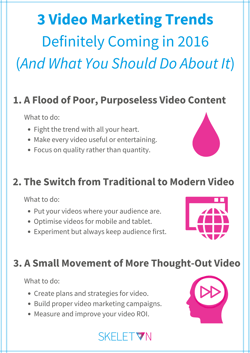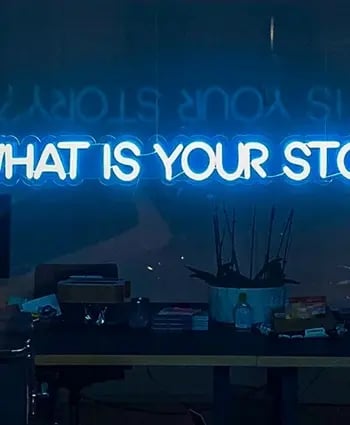3 Video Marketing Trends Definitely Coming in 2016 (And What You Should Do About It)
Brush up with our top 3 predictions for Video Marketing in 2016, and the steps you need to take to stay ahead of the curve.
 Well, another year has rolled round again, in that way they have a habit of doing.
Well, another year has rolled round again, in that way they have a habit of doing.
You're busy digesting the last of your mince pies and family reunions. It's a prime time for reflection and planning ahead. What went well last year? What went badly? What lessons have we learnt for 2016?
When it comes to video marketing, well, it may not be the first thing on your mind at this time of year.
Even if you do work in marketing.
(Especially if you do work in marketing, amirite?)
But if you want video to be part of your marketing strategy this year, or even if you're currently on the fence, you need to start thinking about it now. About your market, your audience, your competition and how you can make the biggest, most effective impact.
To help do this, there are a lot of blog posts and articles that round up the most important video marketing statistics from last year and look forward to this year. Here are two of the best:
- Wyzowl's State of Video Marketing 2015
- Bold Content's 15 Video Marketing Statistics for 2016 (with Infographic)
And while I love poring eagerly over these posts, they often don't do a lot of analysis. They give you the raw data. But they don't try to sift through or seek meaning from that data.
So what do all the numbers actually mean?
What's coming?
Well, let me put on my soothsaying hat and gaze into my crystal ball...
And I'll tell you what I think we can expect from video marketing in 2016, what it means for you and your business, and what you should do about it.
Trend 1: A Flood of 'Meh' Video Content
Here's the problem.
The Numbers
- 78% of marketers say they consider video an important part of their marketing strategy (Wyzowl).
- 61% of marketers said they planned to spend more on video marketing in 2015 than 2014 (Wyzowl).
What It Means
Video content works, which means more and more companies are using more and more of it to achieve their marketing goals. Great, right? Well...
The truth is that, like anything, only video done well gets great results.
Sadly, not everybody gets that.
Remember a few years ago when content marketing was the shiny new thing in the marketing world? (Actually, you may not, but this great documentary about the topic from the Content Marketing Institute will help to set the scene.)
Suddenly company blogs started popping up everywhere, and soon every major brand was on social media, trying to be your cool and knowledgeable best friend.
And now literally everybody is doing it. Now we're drowning in content.
Unfortunately, when everybody starts doing it, cracks start to appear. Business start to create content just for the sake of it, to get (supposedly) bigger and better results, rather than to create something actually good. Standards start to drop. And before you know it we're living in a world of top 10 lists regurgitating the same half-baked thoughts as everyone else.
So what we're actually drowning in is crap, as this pitch-perfect SlideShare illustrates:
Crap. The Content Marketing Deluge from Velocity Partners.
Here's my prediction. Just as it happened to content marketing, I think it's also starting to happen with video marketing.
I'm making my bet that 2016 is the year that almost everybody starts creating video, just like almost everybody started creating content.
I mean, we've already had a taxidermist and a razor blade maker produce hit video content.
 These guys are our video marketing heroes nowadays.
These guys are our video marketing heroes nowadays.
Even dental hygienists and lawyers and waste removal services will do it. (Not to say they shouldn't, just to underline the fact that everyone will do it, even and especially those who didn't previously.)
There will just be too much video! And too much of it will probably be terrible.
Oh sure, there's great stuff out there. Like this gorgeous documentary from Patagonia. Like Volvo's famous epic split. Like pretty much every Vine from Lowe's, an American home improvement store. But there's also tonnes and tonnes of bland, purposeless, unhelpful and uninteresting video from businesses and brands. And it's only going to get worse this year.
Ugh.
What To Do About It
Here's how you should respond to the trend of more and more (bad) video content in 2016.
You should fight it.
You should swim against the tide (and try to keep your head above the crap).
Make every video you create great. Make every video useful, entertaining, and true. Produce video content that is so right for your audience that they'll be begging you to create more.
And if that means you have to create a little less video content so your time, money and resources can stretch further towards creating quality video that actually achieves (or exceeds) your goals, well, that's not exactly the worst thing in the world.
The more video there is, the more you're going to have to stand out from the crowd to be noticed.
So make quality rather than quantity your mantra. Make every video you produce count.
Stop worrying about creating ANY video, and start focusing on creating the RIGHT one.
 "I don't care how good it is, just get us a video!", what you don't want to say.
"I don't care how good it is, just get us a video!", what you don't want to say.
Finally, don't forget that it's not just other brands and businesses that you're up against.
Most of the time (basically, if your video marketing takes place online), you're competing with all the other video content out there on the net, from TV shows to YouTube celebrities. All of this video is fighting for your target audience's time and attention.
Keep this figure in mind:
According to Cisco, it would take somebody 5 million years to watch all the video that will cross global IP networks in a single month by 2019. (!!)
And keep fighting the good fight.
Trend 2: From Traditional to Modern Video
It's been a long time coming, but I think the big shift is going to happen this year.
The Numbers
- Spending on mobile video has increased by 18% since 2014 (AOL Platforms).
- Half of advertisers are moving budget from TV to digital video (AOL Platforms).
- Online video viewing on mobile devices is expected to overtake desktop viewing by Q4 of 2016 (Adobe).
What It Means
We all know that digital, mobile video is exploding. It's been doing it for a while now.
And according to the figures above, 2016 may well be the year when video watching on mobile devices finally exceeds desktops.
This signals a major (and long overdue) change in the way we consume video content.
It's no longer about sitting down to watch your favourite soap opera at the same time every week. Now it's about snackable pieces of video content you can watch on your phone on the way to work, or streaming a movie on your iPad whenever you want it.
We're all moving from traditional ways of watching video (on our TVs, on a computer desktop) to more modern ways (on our mobiles or tablets). And businesses are following our lead.
 Watching cosmic radiation left over from the Big Bang will soon be a thing of the past.
Watching cosmic radiation left over from the Big Bang will soon be a thing of the past.
So here's my prediction: I believe this will be the year that the modern finally overtakes older, outdated ways of watching video.
Even when it comes to brands with a typically older audience, like Simply Supplements, who requested we make them a brand film for their website, they too are making the shift. All the final late adopters are beginning to embrace the change, and soon everybody and their dog will be creating online, digital, mobile video (refer back to Trend 1).
Our brand film created for supplements supplier Simply Supplements (now that's alliteration).
Watching TV at home, in your living room, on your TV screen, is slowly dying a death.
We're all jumping ship.
But with this momentous change comes a great chance for opportunity.
Now we no longer need to interrupt (or, basically, annoy) our audiences. These days we have the ability to place video content on websites and apps and emails that the people we want to reach are already engaging with. This brings along a whole raft of other possibilities:
- More personalisation.
- More interactivity.
- More channels to help reach our target audience (Snapchat, Vine, Periscope).
I'm guessing all of these, and no doubt more I haven't thought of, are going to gain traction over the coming year.
What To Do About It
If the majority of your audience has made the shift to digital, mobile video viewing (and the odds are that they have, remember Simply Supplements?), make sure you're placing your video content where they spend their time online.
Basically, find out how your audience like to consume video, and do it.
Don't feel you have to try new things just for the sake of it. For example, a target audience of 50 to 70-year-olds probably aren't on Periscope. Yet. (Feel free to correct me with evidence to the contrary.)
 "I wish I was on Periscope right now."
"I wish I was on Periscope right now."
But if the data tells you your audience are on a certain platform or app, you should probably follow them there.
You also need to ensure all your video content moving forwards is optimised for mobile and tablet viewing. Don't assume that your target audience will view your videos on desktops, even if you're in B2B. I mean, work tablets are a thing these days.
The last thing you want to do is place difficulties between your audience and your video content. Make it easy for them.
And if you want to try out exciting new things like personalised or interactive video, now's the time.
These are still fairly new technologies that haven't been fully realised yet, so you might just find that you discover a new way of engaging with your target audience that nobody has tried before. For example, just last week the internet was captivated by a livestream of a puddle in Newcastle.
What a time to be alive.
As always, make sure everything you do with video is right for your target audience, rather than just for the sake of it. Keep them in mind and you can't go far wrong.
Trend 3: Less Scattershot, More Targeted
Okay, this one is perhaps more of a wish than a prediction.
The Numbers
- Nearly 6 in 10 marketers say they don't measure their video marketing ROI (Wyzowl).
- 77% of marketers say they aren't sure they can quantify their return on investment in video marketing (Wyzowl).
What It Means
Maybe it's a bit of a contradiction to my belief that we're all shortly going to be drowned in bad corporate video, but I also have a glimmer of hope in my heart.
I hope that, amidst all the poorly planned and executed video content, we are also going to to see a small but significant trend of video that has a thorough and clear strategy behind it. That is targeted with pin-point precision at its audience. That is backed up by a successful marketing campaign.
Here's how I see it playing out:
As more and more companies begin to jump whole-heartedly on the video bandwagon, without necessarily a lot of thought or planning, returns from the medium for these businesses will diminish.
They'll either:
- Fail to generate the results they want.
- Fail to accurately measure those results.
And this is already happening. Just look at the ROI stats up there.
So businesses start to think: wait, wasn't video supposed to be this magical cure-all? What's happening?
 "Why isn't my video content working?"
"Why isn't my video content working?"
Well, successful video takes effort.
It takes effort to make it work and effort to track if it's actually worked or not.
Slowly, some businesses will realise this and begin to put more thought into their videos. They'll create proper briefs and plan how their video content will be distributed to their target audience.
They'll act less like they're holding a shotgun and more like they're holding a sniper rifle.
(Which they are.)
And this will mean a lot of good things for all of us:
- More strategy behind video, rather than wild guesses.
- Video that is more tailored to the audience and their needs/problems.
- More videos marketed properly on the right platforms for their audience.
- Better monitoring and analysis of video content.
What To Do About It
You should embrace it. Try and be part of it.
If this really does start happening (and I've got my fingers crossed), it'll be a cause for celebration. It will show that video is beginning to mature as a form of marketing.
It'll also go some way to combating the problems that will arise from that glut of video content.
We should all be planning out our video content like we would for any other type of content, and any other kind of marketing campaign.
The more solid plans there are behind video content, the more ROI companies will generate, which is good for them. And the more video is tailored to target audiences, the more viewers will be provided with educational and entertaining content, which is good for them.
It's a win-win all round basically.
 Here's a visual representation of what I will feel if everyone starts creating video strategies.
Here's a visual representation of what I will feel if everyone starts creating video strategies.
Round-up: The Year of Bigger and (Hopefully) Better
Well, there you go. Those are my predictions for three major trends in video marketing in 2016.
- An influx of video content as everybody begins to create it, a fair amount of it bad.
- The tipping point as we shift away from traditional video to online, digital, mobile video.
- A small and positive movement of more planned and successful video content.
Obviously, I don't really have a crystal ball, and I don't really know what's coming. But, based on how video marketing has evolved over the years and the way businesses are using it today, I'm fairly certain we'll see all three of these trends emerging or strengthening this year.
Now you just need to make sure you take the right steps to stay ahead of the curve.
That's why I made this neat little poster. You can download it by clicking here.
It features 9 actions you should take this year, based on my 3 trends. You can save it as a PDF! Hang it on your wall! Give it to your kids! Whatever you do with it, it'll help you keep in mind what's important for video marketing success in 2016.
Now all that remains to say is good luck for the year ahead, and let's review in 2017.
Written by Lydia Cockerham Copywriter for Venture Videos — a full-service video production agency that specialises in producing creative videos & campaigns that get real results.





